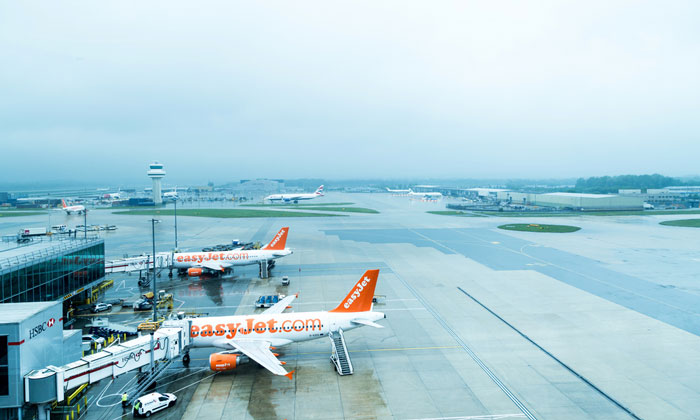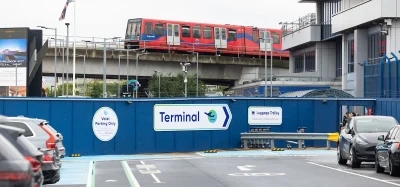Leaders’ Series: Gatwick on ensuring single-runway success
Posted: 9 May 2017 | Chris Woodroofe | No comments yet
COO Chis Woodroofe at Gatwick discusses the importance of repositioning airlines to ensuring success at the world’s busiest single runway airport.


Chris Woodroofe was announced as Gatwick’s COO in November 2016, shortly before completing a major project to create vital new capacity for the airport. Five months on, Chris looks back at the risk-filled project, drawing out themes that will be central to the way he plans to run Gatwick, the world’s busiest single runway airport.
One of Gatwick’s biggest ever projects went largely unnoticed in January and from my perspective that was a clear sign of success.
Widespread media interest would likely have meant something had gone wrong. In this case, I’m delighted to say, British Airways and Virgin Atlantic switched terminals and easyJet consolidated all its operations in our North terminal without so much as a ripple during the 72 hour transition.
Join us live: Shaping the Next Generation of Hold Baggage and Air Cargo Screening
Join us live for an insightful webinar on 11th December at 14:00 GMT, in collaboration with Smiths Detection, as we explore the strategic balance of operational efficiency, regulatory compliance, and sustainability in high-volume security environments.
This session offers a focused look into future-proofing your security strategy.
Key learning points
- Cost Reduction: Strategies to minimize bag travel time while simultaneously reducing operational costs.
- Regulatory Roadmap: Insights into the next wave of regulatory changes and their impact on future investment decisions.
- Sustainable Systems: Practical approaches to building sustainability into security systems and lowering the total cost of ownership (TCO).
- Scalable Solutions: Real-world examples of scalable systems supporting current airport growth and preparing for tomorrow.
Register now for expert insights, case studies, and actionable strategies on operational efficiency!
Success may not have been newsworthy, but repositioning our airlines so that our two biggest, easyJet and British Airways, are based in separate terminals has created a more efficient operating environment and major opportunities for the airport and all its airlines to grow.
The move was also an essential part of Gatwick’s ongoing £2.5 billion transformation programme which is improving every part of the passenger experience – check-in, bag drop, security, lounges, piers, gate rooms and arrivals.
The 72-hour airline transition took place while the airport was in full operation, all be it at a quieter time of year. The switch was fraught with risk so it was only after two years of meticulous planning and the completion of more than 80 building projects that was I happy to give it the green light.
Before I did, I had to be confident that more than 130 stakeholders across the airport could pull this off and for that we needed the right people to lead the job and a very clear methodology for everyone to work to.
The whole transition was run from a 24-hour control hub, which was operated by senior staff from across the airport, representing every part of the operation, including Gatwick, airline and ground handling personnel. In all, more than 10,000 people across the airport were impacted by our Airline Moves project and had a role to play.
Cross functional working is never simple but it is essentially what airports do day in day out. Complex projects like this however require much tighter control, considerably more in-depth planning and of course thorough testing to avoid embarrassment further down the line.
In the case of our ‘Airline Moves’ project, we ran 37 proving trials, five command and control exercises and four full ‘dress rehearsals’ – testing the control hub and all parties represented to the full.
And the final result? The initial impact for me, visually at least, was seeing tail fins in a different place. That’s taken time to get used to, as has walking past impressive new suites of check in desks every morning and the occasional visit to our stunning new lounges.
But when asked what I’m most proud of it is not the shiny new facilities or the sheer scale of the project we pulled off without a hitch – it’s the way everyone worked so well together. And by that I mean everyone in the wider airport family, Gatwick staff and all our partners – airlines, ground handlers, transport operators, retailers and others.
Gatwick family
Our Airline Moves project may now be complete but these vital relationships with our wider airport family will continue to be a central focus for me going forward.
‘Deliver better together’ may sound like a soundbite, but get it right and it can pay dividends. Passengers will experience smoother journeys because the different people responsible for their passage know each other better, know how each other works and can communicate effectively when issues occur. It helps make things run more efficiently and it enhances reputation.
Take our airfield as an example. We only manage to operate the world’s busiest single runway airport – and break record after record – because the various organisations represented on the airfield have optimised how they work together.
Key airfield, ground handlers and airline staff are now based together in one room. All use the same data and all make joint decisions which leads to better choices. These decision are also made more quickly which can be vital at peak times when a different aircraft uses the runway every 60 seconds. Our airfield teams also regularly share and explore issues together in detail so they are better able to evolve and optimise their processes and procedures.
Customer service standards are just as important, particularly in a world when social media can shine an embarrassing bright light on customer-focussed issues when things go wrong.
An airport’s provision for Passengers with Reduced Mobility is a good example. Getting this vital service working properly is not only the right thing to do, but more seamless working with an airport’s PRM service – airport, airline and PRM staff – not only improves standards and enhances reputation, it also improves on-time performance by reducing incidents when aircraft are held up waiting on PRM staff when communication breakdowns occur.
Better understanding and communication between everyone on-site also means that our partners – who are frequently the airport’s public face – are also more likely to be stronger advocates for Gatwick and spread the word about the airport’s good work.
I recognise however that closer working cuts both ways. In return for a better performance from our partners, I see it as my job to explore how we can improve things for third parties working at the airport. It’s too early to say exactly how. It may mean better conditions or more incentives, but my first move is to replicate what we did with Gatwick staff and ask all on-site third parties about their concerns by surveying as many as possible.
Based on what we find out, I’d like to cut a deal with those who are prepared to meet me halfway. I’ll help fix some of their problems and in return, I’d like them to deliver a great experience to our passengers.
With perhaps the exception of the name of the airport and the airline, passengers do not care about the various companies or stakeholders that put their journey together. And why should they? I consider that to be my job and I am working hard behind the scenes with our airport family to make sure that fewer of our passengers ever have to ask why something went wrong.
On time performance
Possibly the most important area for many busy airports to improve on – and the one that causes major inconvenience for passengers – is on-time performance. Like most airports, Gatwick will do everything possible to prevent delays from occurring, but there are limits to our control.
Gatwick and our airlines have implemented a wide range of measures to improve on-time performance in recent years – including being an early adopter of Airport Collaborative Decision Making and incentivising ground handlers for turning aircraft on time – but these measures have been overwhelmed by the scale of wider UK and European airspace issues that cause the bulk of our delays.
We operate in the most congested airspace in the world above London. We also have more flights to Europe than any UK airport and are disproportionately impacted by bottle necks in European airspace. We are also extremely busy for the majority of peak times, so with only a single runway there is little spare capacity to absorb or accommodate delayed aircraft.
So how do I plan to deal with this?
In the immediate term, I am drilling into the minutiae of issues that we can control and handing down responsibility to those in charge, with their performance measured in terms of what they can actually influence.
Breaking the problem down this way presents numerous component parts that can be improved on. Combine these improvements and together they can deliver significant time savings. They will not bring an end to delays, but they will demonstrate that – as an airport – we are doing everything possible to deliver our side of the bargain.
In the longer term we are looking at new infrastructure to support punctuality such as pier extension and more efficient extended taxi ways. And while the bigger issues are not always in our control, we will continue to lobby Government to accelerate its plans to improve the efficiency of UK and European airspace.
Forecasts suggest that most airports should expect a large increase in traffic over the short to medium term. The risk is that this will bring about an increase in air traffic control disruption, with the associated congestion coming our way. As an industry we all have to look closely at our processes and businesses to see how we can respond in the most effective way. Crucially, we have to do so in a coordinated way and soon, before it is too late and our passengers and reputations pay the price.
Cost of operating
One response to capacity constraints in the UK is the Government’s decision to build a new runway in the South East of the country. This process has rumbled on for decades and the Government recently recommended that it should be built at Heathrow, with a final decision expected in 2018.
Gatwick fought hard for the right to build this runway and continues to stand ready to offer a credible and deliverable option for expansion in the UK.
In this crucial time for the UK economy, while some London airports are planning on increasing their charges significantly, I am exploring how we can reduce the costs of operating at Gatwick further. We already offer one of the lowest charges for a major European airport, but I want to ensure that our airlines can make money in what may become an increasingly difficult environment, while continuing to give our passengers the world class experience they have become accustomed to since we came into new ownership in 2009.
We’re currently exploring how we can improve our capacity further so we can continue to deliver growth for our airlines and record-breaking passenger numbers. This may take some major airport reorganisation, but as our Airline Moves project shows – Gatwick does not shy away from major challenges and, together with our wider airport family – we do big, complex projects well.
Facts and stats below illustrate Gatwick’s readiness for the moves
- 277 flights relocated across the 72-hour transition, with 50,000 passengers travelling with the three airlines affected
- 30 scenarios that could affect operation considered, with 52 contingency plans developed and 38 trials successfully concluded
- 25,000 Gatwick-based staff directly affected, 140 working groups set up to manage the transition and 130 stakeholder organisations engaged
- Dedicated team of 70 people worked on Airline Moves for two years
- 84 construction projects to enable the moves, with 100 properties, representing 20,000 square metres of space around Gatwick campus affected
About Chris Woodroofe
Previously Head of Passenger Operations, Chris has spent more than ten years at the airport and has a breadth of knowledge gained in a number of key roles including Head of Engineering and Head of Security & Business Continuity. Chris is a graduate of Imperial College London gaining a first class master’s degree in Chemical Engineering as well as an MBA with distinction from the University of Warwick.
The International Airport Summit is open for registration!
Date: 19 – 20 November 2025
Location: JW Marriott Hotel Berlin
At our flagship event of the year, we will dive into the future of airport operations, with expert-led sessions on passenger experience, innovative smart technologies, baggage handling, airside operations, data, security, and sustainability.
This is where global airport leaders come together to share insights, challenges, and real-world solutions.
Limited complimentary passes are available for eligible professionals – first come, first served!


















